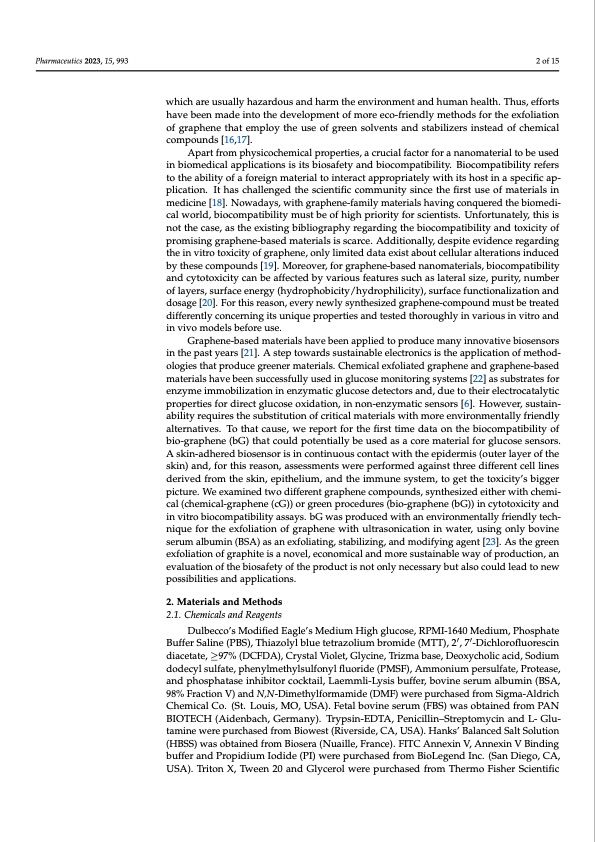
PDF Publication Title:
Text from PDF Page: 002
Pharmaceutics 2023, 15, 993 2 of 15 which are usually hazardous and harm the environment and human health. Thus, efforts have been made into the development of more eco-friendly methods for the exfoliation of graphene that employ the use of green solvents and stabilizers instead of chemical compounds [16,17]. Apart from physicochemical properties, a crucial factor for a nanomaterial to be used in biomedical applications is its biosafety and biocompatibility. Biocompatibility refers to the ability of a foreign material to interact appropriately with its host in a specific ap- plication. It has challenged the scientific community since the first use of materials in medicine [18]. Nowadays, with graphene-family materials having conquered the biomedi- cal world, biocompatibility must be of high priority for scientists. Unfortunately, this is not the case, as the existing bibliography regarding the biocompatibility and toxicity of promising graphene-based materials is scarce. Additionally, despite evidence regarding the in vitro toxicity of graphene, only limited data exist about cellular alterations induced by these compounds [19]. Moreover, for graphene-based nanomaterials, biocompatibility and cytotoxicity can be affected by various features such as lateral size, purity, number of layers, surface energy (hydrophobicity/hydrophilicity), surface functionalization and dosage [20]. For this reason, every newly synthesized graphene-compound must be treated differently concerning its unique properties and tested thoroughly in various in vitro and in vivo models before use. Graphene-based materials have been applied to produce many innovative biosensors in the past years [21]. A step towards sustainable electronics is the application of method- ologies that produce greener materials. Chemical exfoliated graphene and graphene-based materials have been successfully used in glucose monitoring systems [22] as substrates for enzyme immobilization in enzymatic glucose detectors and, due to their electrocatalytic properties for direct glucose oxidation, in non-enzymatic sensors [6]. However, sustain- ability requires the substitution of critical materials with more environmentally friendly alternatives. To that cause, we report for the first time data on the biocompatibility of bio-graphene (bG) that could potentially be used as a core material for glucose sensors. A skin-adhered biosensor is in continuous contact with the epidermis (outer layer of the skin) and, for this reason, assessments were performed against three different cell lines derived from the skin, epithelium, and the immune system, to get the toxicity’s bigger picture. We examined two different graphene compounds, synthesized either with chemi- cal (chemical-graphene (cG)) or green procedures (bio-graphene (bG)) in cytotoxicity and in vitro biocompatibility assays. bG was produced with an environmentally friendly tech- nique for the exfoliation of graphene with ultrasonication in water, using only bovine serum albumin (BSA) as an exfoliating, stabilizing, and modifying agent [23]. As the green exfoliation of graphite is a novel, economical and more sustainable way of production, an evaluation of the biosafety of the product is not only necessary but also could lead to new possibilities and applications. 2. Materials and Methods 2.1. Chemicals and Reagents Dulbecco’s Modified Eagle’s Medium High glucose, RPMI-1640 Medium, Phosphate Buffer Saline (PBS), Thiazolyl blue tetrazolium bromide (MTT), 2′, 7′-Dichlorofluorescin diacetate, ≥97% (DCFDA), Crystal Violet, Glycine, Trizma base, Deoxycholic acid, Sodium dodecyl sulfate, phenylmethylsulfonyl fluoride (PMSF), Ammonium persulfate, Protease, and phosphatase inhibitor cocktail, Laemmli-Lysis buffer, bovine serum albumin (BSA, 98% Fraction V) and N,N-Dimethylformamide (DMF) were purchased from Sigma-Aldrich Chemical Co. (St. Louis, MO, USA). Fetal bovine serum (FBS) was obtained from PAN BIOTECH (Aidenbach, Germany). Trypsin-EDTA, Penicillin–Streptomycin and L- Glu- tamine were purchased from Biowest (Riverside, CA, USA). Hanks’ Balanced Salt Solution (HBSS) was obtained from Biosera (Nuaille, France). FITC Annexin V, Annexin V Binding buffer and Propidium Iodide (PI) were purchased from BioLegend Inc. (San Diego, CA, USA). Triton X, Tween 20 and Glycerol were purchased from Thermo Fisher ScientificPDF Image | Green Exfoliation of Graphene

PDF Search Title:
Green Exfoliation of GrapheneOriginal File Name Searched:
pharmaceutics-15-00993.pdfDIY PDF Search: Google It | Yahoo | Bing
Salgenx Redox Flow Battery Technology: Power up your energy storage game with Salgenx Salt Water Battery. With its advanced technology, the flow battery provides reliable, scalable, and sustainable energy storage for utility-scale projects. Upgrade to a Salgenx flow battery today and take control of your energy future.
| CONTACT TEL: 608-238-6001 Email: greg@infinityturbine.com | RSS | AMP |